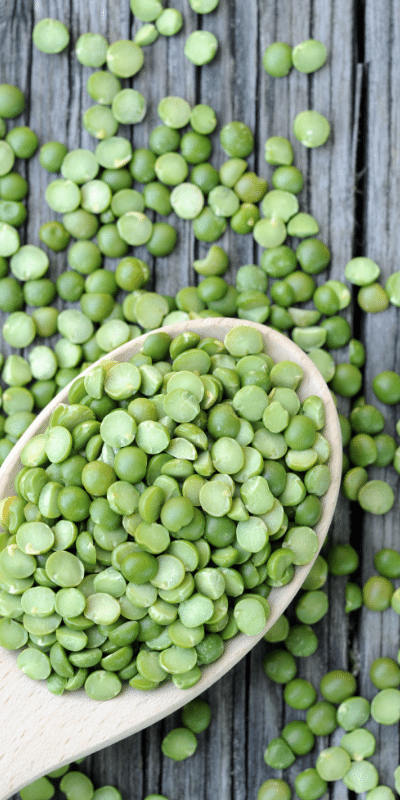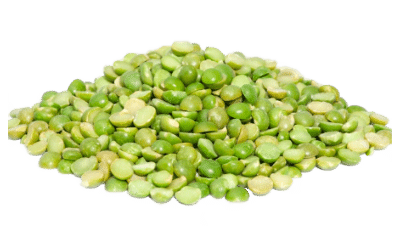
Health benefits
of split peas
Split peas are part of the legume family and have many benefits for people and for the planet. They are an essential ingredient for the food transition. Split peas are rich in carbohydrates, proteins and fibre, and contain many minerals:
- They are a source of Magnesium helps, among others, to reduce fatigue, keep our muscles working properly, maintain our energy metabolism and a normal nervous system function.
- Rich in iron: Iron helps, among others, to maintain normal cognitive function, energy metabolism and a healthy immune system.
- Rich in potassium: Potassium helps to maintain a healthy immune system, muscle function, as well as normal blood pressure.
- Rich in phosphorus. Phosphorus contributes to strong bones and healthy teeth, as well as energy metabolism.
Nutritional
values
The right time
to eat them
Split peas reach full maturity in summer, from June to July. Once dried, they can be eaten all year round.
Vegetable garden
or city balcony
Split peas come from a type of round peas. Once they have been harvested, they are dried, stripped of their husks and halved. Split peas – like peas – come from the seed of a variety of annual plant. The only difference between peas and split peas is that peas are eaten fresh, while split peas are stripped of their cellulose outer skin, split into two parts and dried. Split peas are therefore classified as pulses.
Split peas are grown in open fields, and the plant has very distinctive leaves and butterfly-shaped flowers, which can be white, pink or red. Like wheat, the plant has self-pollinating flowers, meaning they don’t need pollen from another plant to be fertilised.
Choosing
and storing
Split peas will keep for several months if stored in an airtight container in a dry place away from light.
Once cooked, they can be kept in the fridge for up to 48 hours on average. Cooked split peas can be frozen to keep for longer.
Tips
and tricks
Split peas are best known for their use in soups or purees, served with bacon, for example. They can be found in many types of cuisine: split pea soup is often found in Northern Europe and North America. In the Middle East, however, dried peas are prepared as a stew.
In the Middle East, however, dried peas are prepared as a stew. In Britain, they are used to make pease pudding. In Indian cuisine, we find them in traditional dahls and curries, and as spiced patties. Why not eat them roasted and salted, like in Asia? Just soak them, add oil and spices, and put them in a pre-heated oven at 200°C for 15-20 minutes.
What is their
environmental impact?
We can find out more from their PEF (Product Environmental Footprint) score! This is a score established by Agribalyse*. It takes into account every stage in a vegetable’s life cycle: how it’s cultivated, what is the impact of processing and transport, etc. The lower the score, the lower its environmental impact.
- Split pea, dried : 0.12
- Raw beef steak: 2.77
*Figures drawn from the Agribalyse database, which calculates the environmental score of different types of food. This unique score is a weighted average of 16 indicators, calculated according to the European PEF methodology. It does not correspond to an environmental label or ‘eco-score’.
CO2 equivalent: for 100g of dried split peas, 0.366kg of CO2 eq, or as much as from 10.8g of raw beef steak.

Can everyone eat them?
Babies can eat pulses such as split peas from the age of six months. Add them gradually, with one or two spoonfuls of mashed cooked split peas. From the age of 12 months, young children can eat up to 70 grams of cooked pulses a day.
The consumption of pulses remains low among the general public, yet they are essential for a more sustainable diet. They have a reduced environmental footprint and provide essential nutrients for humans.
Where do they come from?
The origins and varieties of split peas
Peas originated in the Near and Middle East, as far back as barley and wheat! Their culture then spread towards Europe and Asia. Today, they are most commonly grown in Asia.
There is a great variety of peas, of different shapes and colours. There are peas with yellow, green or even, more rarely, pink cotyledons, mottled with brown, red or green. Their seeds can be round and smooth, or wrinkled…



 Fava beans
Fava beans  Onions
Onions  Vegetable growing: Brussels sprout
Vegetable growing: Brussels sprout 









